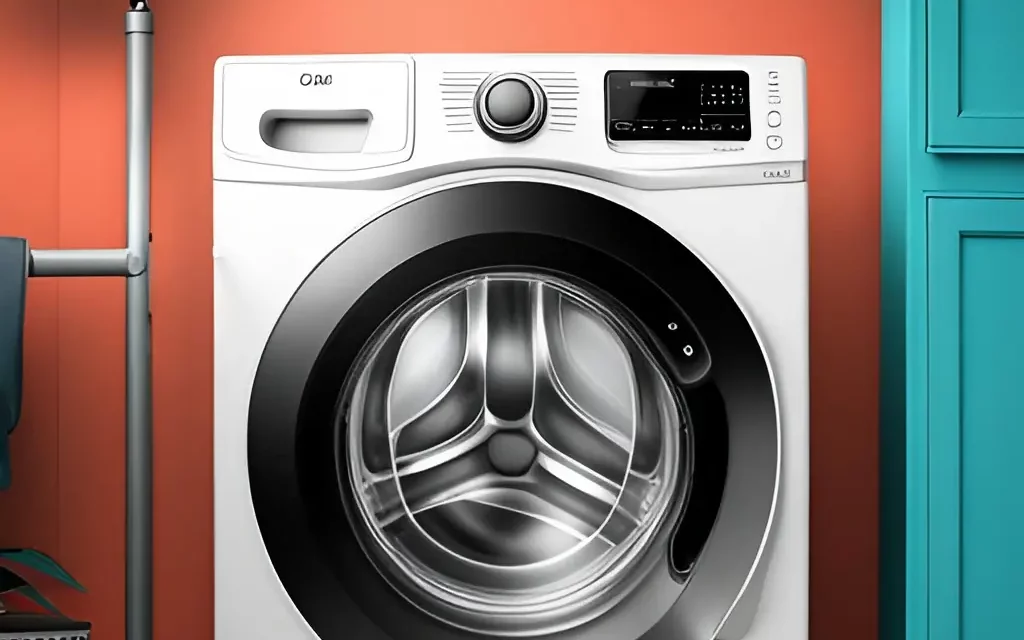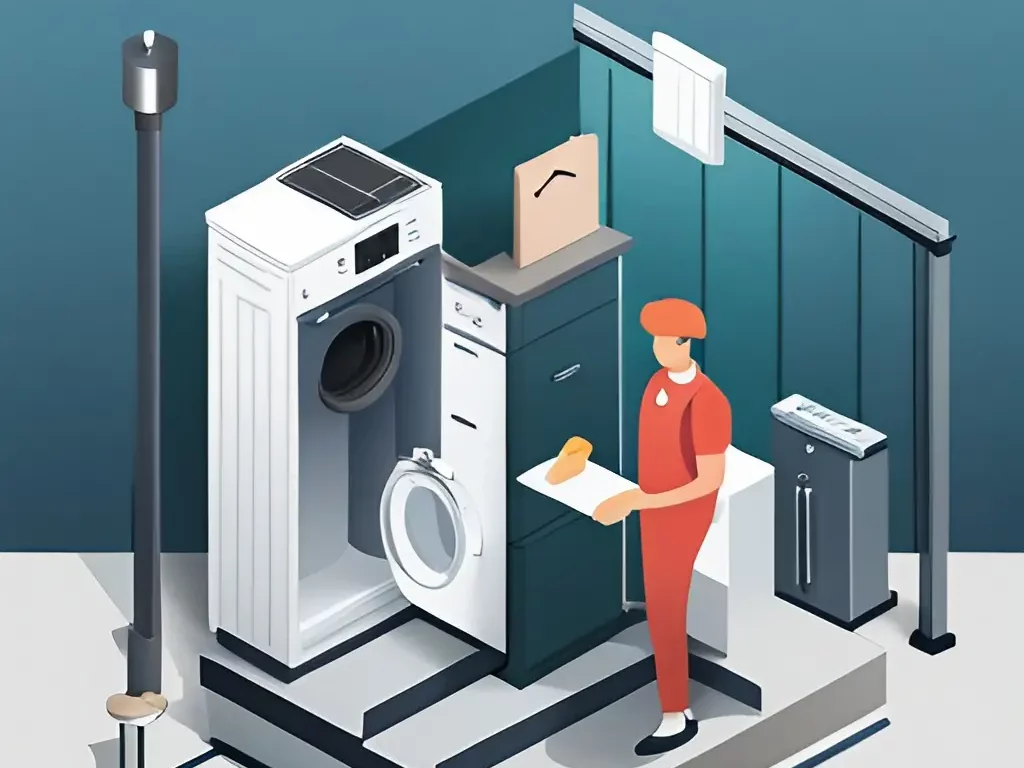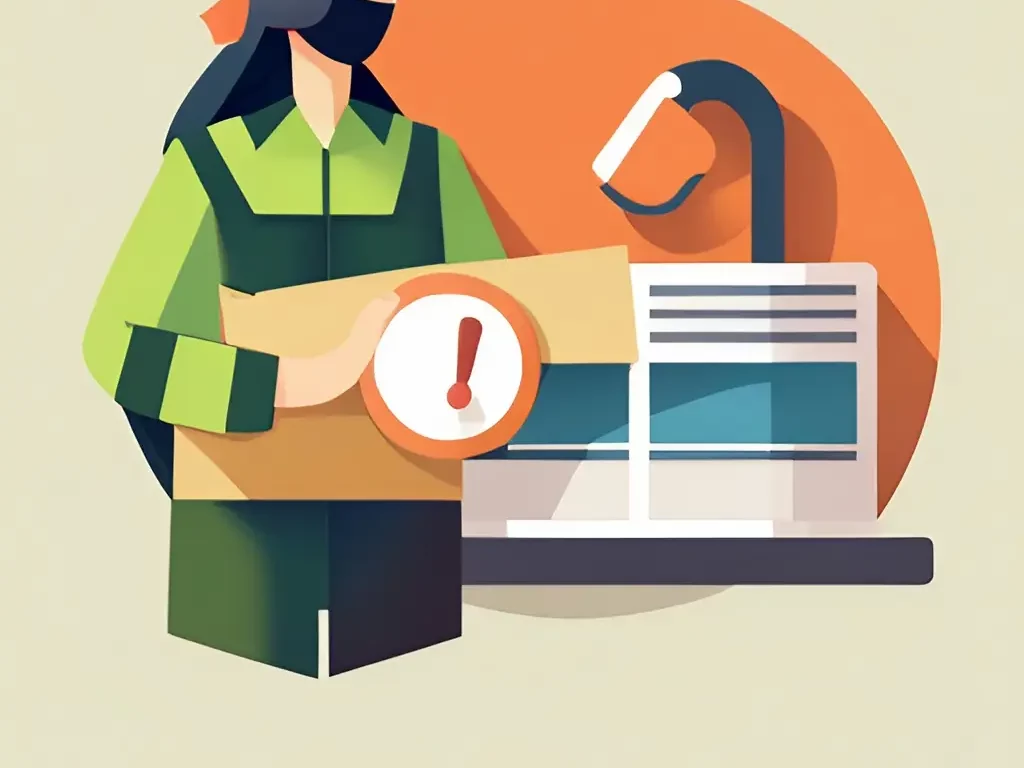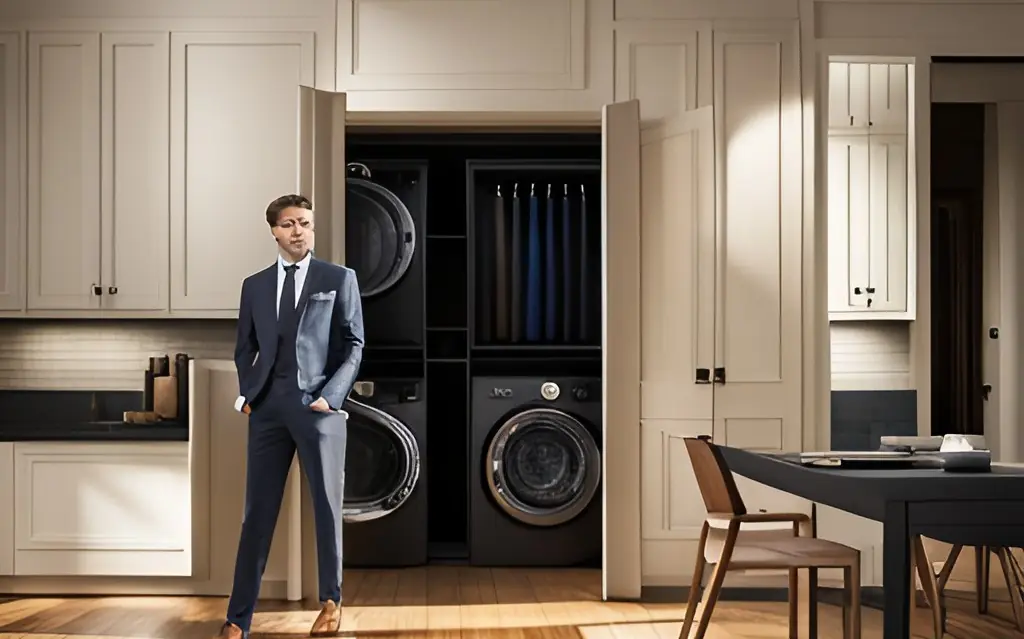Facing an error code on your Samsung front-load washer can be a little unnerving, but with a systematic approach, you may be able to solve the issue yourself.
Here’s a quick reference to the top error codes you might encounter and how to handle them effectively.
Samsung Washer Error Codes
4E/4C: Water Supply Problems
What It Means: The machine detects a water supply issue.
Troubleshooting Steps:
- Ensure the water supply faucets are fully turned on.
- Check the water inlet hoses for kinks or bends.
In-Depth Troubleshooting for 4E/4C Errors:
Here are the in-depth steps for you to follow:
- Check Water Pressure:
- Use a water pressure gauge on your faucet to confirm that your household water pressure is between 20 and 116 psi. If it’s lower than 20 psi, the washer may fail to fill adequately.
- Inspect the Inlet Filters:
- I found that removing the water hose from the back of the washer and cleaning the inlet filters of any buildup of sediment greatly improved the water flow.
- Straighten Hoses:
- Make sure there are no twists or extreme bends in the hoses that could restrict water flow.
- Conduct a Cleaning Cycle:
- Over time, small particles can build up inside the machine. Running a cleaning cycle without clothes can help flush out any debris that might be causing a hindrance.
Remember, safety first: always disconnect the power before performing these checks.

5E/SE: Drainage Issues
What It Means: The washer fails to drain properly.
Troubleshooting Steps:
- Examine the drain hose for any clogs or pinches.
- Verify that your household plumbing allows proper water flow.
In-Depth Troubleshooting for 5E/SE Issues:
Here’s how we can tackle these drainage problems:
Check the Drain Hose:
- First, I always suggest ensuring the drain hose is properly installed. The hose should not be inserted more than 6 inches into the drainage pipe. Also, look for any kinks or obstructions inside the hose that may impede water flow.
Inspect the Debris Filter:
- Regular maintenance includes checking the debris filter, which is often located at the front lower part of the washer. I’ve found through my own experience that cleaning out lint and small items from the filter can prevent a lot of drainage headaches.
Test the Drain Pump:
- If your washer is humming or making unusual noises, the drain pump might be clogged or defective. Safely accessing and inspecting the pump for obstacles could be your next step. If needed, consulting with a professional or involving Samsung’s customer service may be prudent.
Assess the Washing Machine’s Level:
- Sometimes the simplest things can cause the biggest troubles. Check to ensure your washer is level because an uneven washer can lead to improper draining.
Monitor for Code Recurrence:
- After taking these steps, try running your machine again to see if the error persists. If it does, documenting when and how it occurs can offer helpful clues for further troubleshooting or when discussing the issue with a technician.
Please make sure to disconnect from power before attempting any troubleshooting, and don’t hesitate to reach out to a professional if you’re in over your head. Your safety is paramount.
ND: No Drain Error
What It Means: An extended drain time is detected.
Troubleshooting Steps:
- Clean the drain pump filter and inspect the impeller.
- Ensure the drain hose is not bent or blocked.
In-Depth Troubleshooting for ND Error:
When facing the ND error on your Samsung front-load washer, it’s a signal to check the drainage system meticulously.
- Examine the Drain Pump Filter:
- I always start by checking the drain pump filter for any obstructions. In my experience, a clogged filter is a common culprit. To get to the filter, you’ll need to remove the panel at the front bottom of the washer (ensure the machine is off and unplugged before you do this). Clean out the filter thoroughly and rinse it under running water.
- Check Impeller Functionality:
- While the filter is off, take a moment to verify that the impeller, which is the fan-like component behind the filter, can rotate freely. If it’s stuck, gently remove any obstructions with a pair of tweezers.
- Straighten and Inspect the Drain Hose:
- A bent or blocked drain hose can also cause the ND error. Ensure the hose is straight and free of kinks. You might have to disconnect it to give it a good check—it’s sometimes as simple as removing a small sock or a buildup of lint hiding in the hose!
- Use Water to Detect Blockages:
- An effective method I’ve adopted involves detaching the hose from the back and then running water through it. If water flows freely, it’s clear; if not, there’s a blockage that needs your attention.
- Verify Hose Installation:
- Ensure the drain hose is securely and correctly attached to your home’s plumbing and that it’s not pushed too far down the standpipe. This could lead to siphoning, which prevents proper draining.
- Test the Drain Pump Electricals:
- Occasionally, the issue might be electrical and not mechanical. If you’re comfortable using a multimeter, you can check the pump for electrical continuity to ensure it’s functioning properly. Be mindful that this step is best left to professionals if you’re not familiar with electrical systems.
- Listen for Unusual Sounds:
- After reassembling and reconnecting your washer, listen for any abnormal sounds when you test the drain function. Strange noises could indicate a deeper issue with the pump or motor that might require professional assessment.
- Contact Customer Service:
- If these steps don’t resolve the ND error, it might be time to involve Samsung’s customer support. They can provide additional guidance or service if necessary.
Remember, safety is always the priority. Ensure the washer is disconnected from the power source before diving into these troubleshooting steps, and when in doubt, enlist the expertise of a qualified technician. Not only does this approach help to maintain your washer, but it also ensures it serves you well for years to come.

UE: Unbalanced Load
What It Means: An unbalanced load is detected during the spin cycle.
Troubleshooting Steps:
- Evenly redistribute the laundry inside the drum.
- Avoid overloading the washer; stick to recommended loads.
In-Depth Troubleshooting for UE Error:
Handling a UE error—that infamous unbalanced load signal—can be straightforward if you follow these recommendations:
Redistribution of Clothes:
- I’ve often found that simply opening the washer, taking a moment to evenly distribute the clothes around the drum, and then restarting the spin cycle can solve the UE error. It’s amazing what a little rearranging can do.
Check for Overloading:
- We need to remember not to overfill the washer. I advise using the manual’s recommended load size as a guide, as overloading can impair the machine’s ability to properly balance the laundry and is often the root cause of the UE error.
Single Heavy Items:
- It’s also important to avoid washing single heavy items, like a large towel or a heavy blanket, by themselves. I recommend adding other items to balance the load, which can prevent the unbalanced error message.
Adjusting the Feet:
- Checking that the washer is perfectly level by adjusting its feet may seem trivial, yet it’s a critical step. An unlevelled washer can easily cause loads to become unbalanced during the spin cycle. Use a spirit level to confirm that everything’s even.
Inspect the Drum and Suspension:
- Sometimes, the issue might not be with the load itself, but with the drum or suspension system. If you’re comfortable, inspect these or have a professional do so. Worn-out suspension rods or springs can lead to unbalanced loads.
Perform a Calibration Cycle:
- Some washers offer a calibration function. It’s a simple process that recalibrates the weight sensors. Consult your user manual to see if this feature is available and how to perform it—it’s usually as easy as pressing a few buttons.
DC: Unbalanced Dryer Load
What It Means: An unbalanced dryer load affects the spin of the drum during the drying cycle.
Troubleshooting Steps:
- Rearrange the items inside for a more even distribution.
In-Depth Troubleshooting for DC Error:
Working through a DC error, indicative of an unbalanced dryer load, might look challenging, but it’s a fixable issue if we tackle it systematically:
Rearrange the Drying Load:
- The solution might be as simple as opening up the dryer and moving the items around for equal weight distribution. It’s essential to spread items out and avoid heavy clumping for smoother operation.
Avoid Overloading the Dryer:
- It’s a common mistake to overstuff the dryer, but this can lead to imbalance issues and strain the motor. By following the manufacturer’s recommended capacity, which I find in the user manual, I ensure optimal performance and prolong the lifespan of the unit.
Balance the Drum:
- Sometimes, the drum itself may be the problem. I check for signs of wear and tear or misalignment, which could contribute to an unbalanced load. It might be necessary to adjust the drum or have a professional look at it.
Check the Dryer’s Position:
- Ensuring the dryer is level is crucial. An uneven surface can cause the dryer to tilt, and during operation, this minor tilt can greatly affect the balance of the load. I use a level to confirm that all feet are properly adjusted and the appliance is sitting flat.
Reduce Mixed Fabric Loads:
- Different fabrics can dry at different rates, leading to an unbalanced condition as items stick together. Where possible, I dry similar types of fabrics together to maintain an even load throughout the cycle.
Utilize Dryer Balls or Sheets:
- An added step I sometimes suggest is the use of dryer balls or sheets. These can help to keep items separated and improve airflow within the drum, promoting a more balanced tumble and more efficient drying.
Reset or Recalibrate the Dryer:
- Some models have a calibration setting that I’ve used effectively to address DC errors. This procedure resets the sensors that detect imbalance, which can be found detailed step-by-step in the user’s manual.
As with any troubleshooting, ensure that your dryer is disconnected from the power source before beginning your work to maintain safety. If you proceed methodically and check each of these points, the persistent DC error should be resolved, restoring the dryer to its peak performance.

OE/DE: Door Lock Issues
What It Means: The door fails to lock properly for the cycle to start.
Troubleshooting Steps:
- Check the door for any obstructions or misalignments.
- Make sure the door is latching correctly.
In-Depth Troubleshooting for OE/DE Issues:
Examine the Door Latch:
- If I notice that the door isn’t latching, my first move is to inspect the latch mechanism for any damage or debris. Sometimes, cleaning away lint or small objects that obstruct the latch can be all it takes to fix the issue.
Check the Door Seal:
- I also look closely at the rubber seal around the door, known as the gasket. Any wear, tear, or foreign objects caught in the seal could prevent the door from closing properly. Keeping this seal clean ensures a proper lock.
Inspect Electrical Connections:
- It’s easy to overlook, but faulty wiring to the door lock assembly might be the culprit. I verify all connections are secure and, if I’m unsure, I consult a technician to avoid further electrical issues.
Test the Door Lock Mechanism:
- If the door seems to close but doesn’t lock, the lock mechanism might be at fault. Some models allow for manual testing, which I perform with caution, or this may be a task best left to a professional.
Replace Faulty Parts:
- Persistent problems might indicate a need for replacement parts. I check if the warranty covers these and either order parts from the manufacturer or seek assistance from an authorized repair service.
Reset the Machine:
- As a last resort, I might need to reset the entire machine. This might solve a glitch in the system that’s causing the door to remain unlocked. The process usually involves unplugging the machine for a minute and then powering it back on.
LE/E9: Motor Problem
What It Means: The washer detects an issue with the electric motor.
Troubleshooting Steps:
- Look for any visible signs of overheating or part malfunctions.
- It’s best to contact a professional for motor issues.
In-Depth Troubleshooting for LE/E9 Error:
Addressing an LE/E9 error, signaling a motor issue with the washer, can be daunting, but with the right approach, it’s manageable. Let me guide you through the steps I take:
Inspect the Motor:
- The first thing I check for is any sign of damage or wear to the motor itself. If there’s any visible burning or smell, this indicates a serious problem.
Check the Motor’s Electrical Connections:
- I make it a point to examine the wiring and connectors leading to the motor. Any loose or damaged wires can cause motor errors that I often can fix by simply re-securing the connection.
Assess the Motor Control Board:
- The control board is the brain of the washer, and I know it can sometimes be the source of motor-related problems. I look for any burned areas on the board or possible fault codes displayed, which can indicate specific issues.
Look for Obstructions:
- Objects trapped in the washer drum can put a strain on the motor. I ensure that nothing is obstructing the drum’s movement which might be causing the LE/E9 error.
Test Capacitors:
- Motor start and run capacitors can fail, leading to motor function issues. I test these components with a multimeter and replace them if needed.
Consider Motor Replacement:
- If troubleshooting suggests motor failure, and it’s beyond repair, I weigh the cost of replacement against the age and overall condition of the washer.
Motor problems can be complex, and working with electrical components carries inherent risks. Always prioritize safety and disconnect power before beginning any troubleshooting.
HE/Temperature Sensor Malfunction
What It Means: This error indicates an issue with the heating system or temperature sensor during a cycle.
Troubleshooting Steps:
- Check for blockages in the heating element or sensor.
- For complex repairs, consult a technician familiar with your model.
In-Depth Troubleshooting for HE Issues:
Here’s how I approach the situation:
- Examine the Heating Element: Often, I start by inspecting the heating element for any signs of damage or corrosion. Sometimes, a simple visual inspection reveals areas that may be causing poor performance or failure.
- Test Temperature Sensors: Using my multimeter, I carefully test the temperature sensors for correct operation. I refer to the service manual for specific resistance values at a given temperature to ensure accuracy.
- Check Wiring and Electrical Connections: It’s essential to check all associated wiring for signs of wear or damage. Loose or corroded connectors can lead to intermittent or faulty sensor readings.
- Clean the Heat Exchanger (if applicable): Some models feature a heat exchanger that can become clogged with lint or debris, disrupting normal operation. I make sure this component is clear and functioning properly.
- Consult the Error Code Chart: I consult the manufacturer’s chart to interpret any additional fault codes. This can provide a more precise diagnosis, directing me towards the underlying issue.
- Contact an Authorized Service Technician: If troubleshooting doesn’t resolve the issue, I advise calling a professional. They’re equipped with the tools and expertise to safely resolve complex heating system faults.
Follow Safety Protocols:
- Above all, during these steps, I emphasize safety. Ensuring the machine is unplugged and taking proper precautions is always my top priority while I troubleshoot.
Excessive Suds (SUD)
What It Means: The washer detects excess sudsing, which may affect rinsing and draining.
Troubleshooting Steps:
- Use the appropriate amount and type of detergent.
- Consider switching to a low-sudsing detergent.
In-Depth Troubleshooting for SUD Issues:
In-Depth Troubleshooting for SUD Issues:
When confronted with a SUD issue in a washer, it’s essential to tackle it systematically. Here’s the path I follow to diagnose and resolve excessive sudsing:
Assess Detergent Usage:
- The first step I take is evaluating the amount and type of detergent used. I ensure that I’m following the manufacturer’s recommendations since using too much detergent or the wrong type can easily cause excessive suds.
Detergent Type and Washer Compatibility:
- I check if the detergent is compatible with high-efficiency washers if applicable. These machines require low-sudsing, high-efficiency detergents to operate correctly.
Inspect the Drum and Drainage System:
- It’s crucial to examine the drum and drainage system for any obstructions that could cause a sudsy backlog. I look for soap buildup, lint, or small items that might hinder proper drainage and clean them thoroughly.
Run a Cleaning Cycle:
- I often run a washer cleaning cycle using a washing machine cleaner or a homemade mixture of white vinegar and baking soda. This helps break down any residual suds and prevents their recurrence.
Check for Mechanical Faults:
- Persistent sudsing may indicate a mechanical issue. I examine components such as the water level sensor and the drain pump for any faults that may contribute to inadequate rinsing or draining.
Remember to always disconnect the power to the washer before attempting any troubleshooting or repairs.
For more detailed guidance, always refer to your user manual or reach out to Samsung’s official support for personalized assistance. Remember, a little troubleshooting can go a long way in keeping your washer running smoothly and efficiently.
Below is a comprehensive table summarizing the error codes, their meanings, and the troubleshooting steps for your convenience.
| Error Code | Meaning | Troubleshooting Steps |
|---|---|---|
| 4E/4C | Water Supply Problems | Ensure water faucets are fully open. Check water inlet hoses for kinks. |
| 5E/SE | Drainage Issues | Examine drain hose for clogs. Ensure good household plumbing flow. |
| ND | No Drain Error | Clean drain pump filter. Inspect impeller for obstructions. |
| UE | Unbalanced Load | Redistribute laundry evenly in drum. Do not overload the washer. |
| DC | Unbalanced Dryer Load | Rearrange items inside dryer for even distribution. |
| OE/DE | Door Lock Issues | Remove obstructions from door. Ensure door latches correctly. |
| LE/E9 | Motor Problem | Look for overheating signs. Contact a professional for issues. |
| HE | Temperature Sensor Malfunction | Check for heating element/sensor blockages. Consult a technician for repairs. |
| SUD | Excessive Suds | Use the correct detergent amount/type. Opt for low-sudsing detergents. |
Additional Tips for Maintaining Your Samsung Front-Load Washer
Aside from addressing error codes, there are some general tips that can help maintain the performance and longevity of your Samsung front-load washer:
- Clean the machine regularly using a mild detergent and warm water.
- Leave the door open after use to allow for proper air circulation and prevent odors.
- Use the appropriate amount of detergent according to load size and soil level.
- Perform regular maintenance tasks such as checking the drain pump filter and inspecting hoses for wear or damage.
By following these tips, you can ensure that your Samsung front-load washer continues to provide efficient and reliable performance for years to come.
Conclusion – Samsung Washer Error Codes
In this guide, we covered some of the most common error codes on Samsung front-load washers and provided troubleshooting steps for each one. We also shared additional tips to help maintain your washer’s performance and durability. Remember, with a little knowledge and effort, you can easily address many issues yourself and keep your washer running smoothly.
Additional Articles:
For those in need of further guidance on home appliance maintenance, I have additional troubleshooting articles available for common household brands. If you’re experiencing issues with your Frigidaire ice maker, you can find insightful troubleshooting tips here: Frigidaire ice maker troubleshooting. Similarly, if you’re facing problems with your Whirlpool dishwasher, make sure to check out this resource: Whirlpool dishwasher troubleshooting.
Furthermore, if you’re dealing with robotic cleaning assistance, don’t miss my comprehensive guide on troubleshooting a Roomba Robot Vacuum: Troubleshoot Roomba Robot Vacuum. For a detailed visual walkthrough specifically addressing Samsung washer error codes, I invite you to watch my informative troubleshooting video: Samsung washer error codes troubleshooting video.
- Self-Watering Gardens for Small Spaces: Grow Big in Tiny Places
- How To Conserve Water At Home | How Can I Lower My Water Bill?
- Outdoor Pizza Oven Buying Guide | How to Buy
- Top Stand Mixers on Amazon: Most Wished For
- Samsung Robot Vacuum Troubleshooting + Advice

I’m J.S., I created and am the content manager at DIYHouseSkills.com. I do the research and write the articles that appear on this website. I’ve learned many household skills during my life and think it’s important to at least know the basics so that you can save yourself time and money… READ FULL BIO >
